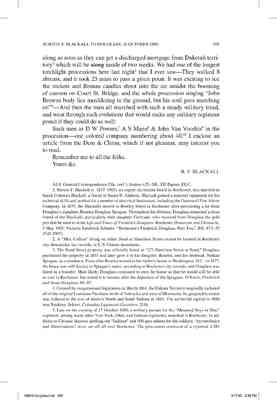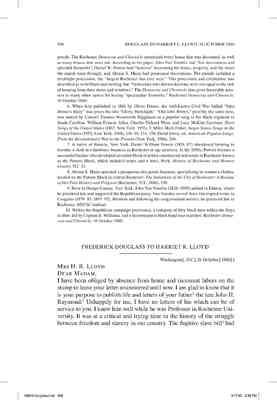Pages
page_0001
BURTON F. BLACKALL1Burton F. Blackall (c. 1833–1901), an expert electrician based in Rochester, was married to Sarah Coleman Blackall, a friend of Susan B. Anthony. Blackall gained a national reputation for his technical skills and worked for a number of electrical businesses, including the Gamewell Fire Alarm Company. In 1875, the Blackalls moved to Rowley Street in Rochester after purchasing a lot from Douglass’s daughter, Rosetta Douglass Sprague. Throughout his lifetime, Douglass remained a close friend of the Blackalls, particularly their daughter Gertrude, who received from Douglass the gold pen that he used to write Life and Times of Frederick Douglass. Rochester Democrat and Chronicle, 1 May 1901; Victoria Sandwick Schmitt, “Rochester’s Frederick Douglass, Part Two,” RH, 67: 1–55 (Fall 2005). TO FREDERICK DOUGLASS
Rochester, N.Y. 16 Oct[ober] 1880.
FREDK DOUGLASS
DEAR FRIEND.
Enclosed please find draft for $123.00 covering Mrs Collins2A “Mrs. Collins” living on either Bond or Hamilton Street cannot be located in Rochester city directories, tax records, or U.S. Census documents. interest, and rent of Bond st. property.3The Bond Street property was officially listed as “271 Hamilton Street at Bond.” Douglass purchased the property in 1855 and later gave it to his daughter, Rosetta, and her husband, Nathan Sprague, as a residence. Even after Rosetta moved to her father’s home in Washington, D.C., in 1877, the house was still deeded in Sprague’s name, according to Rochester city records, and Douglass was listed as a boarder. Most likely, Douglass continued to own the house so that he would still be able to vote in Rochester, but rented it to tenants after the departure of the Spragues. O’Keefe, Frederick and Anna Douglass, 86–87. Mrs Collins was a month behind. and the party living in your house cannot pay rent until they receive a remittance of $4000 which was left them by a relative living in Michigan. It will be
page_0002
along as soon as they can get a discharged mortgage from Dakotah territory4Created by congressional legislation in March 1861, the Dakota Territory originally included all of the original Louisiana Purchase north of Nebraska and west of Minnesota. Its geographic extent was reduced to the size of modern North and South Dakota in 1864. The territorial capital in 1880 was Yankton. Seltzer, Columbia Lippincott Gazetteer, 2116. which will be along inside of two weeks. We had one of the longest torchlight processions here last night5Late on the evening of 15 October 1880, a military parade for the “Mounted Boys in Blue” regiment, among many other New York, Ohio, and Indiana regiments, marched in Rochester. In addition to Chinese lanterns spelling out “Indiana” and 100-gun salutes for the soldiers, “pyrotechnics and illuminations” were set off all over Rochester. The procession consisted of a reported 2,581 people. The Rochester Democrat and Chronicle mentioned every house that was decorated, as well as many houses that were not. According to the paper, John Van Voorhis had “fine decorations and splendid fireworks”; Daniel W. Powers had “lanterns” decorating his house, property, and the street the march went through; and Abram S. Mann had prominent decorations. The parade included a torchlight procession, the “largest Rochester has ever seen.” This procession and celebration was described as so brilliant and exciting that “Democrats who did not decorate were not equal to the task of keeping from their doors and windows.” The Democrat and Chronicle also gives honorable mention to many other names for having “spectacular fireworks.” Rochester Democrat and Chronicle, 16 October 1880. that I ever saw—They walked 8 abreast, and it took 25 mins to pass a given point. It was exciting to see the rockets and Roman candles shoot into the air amidst the booming of cannon on Court St. Bridge. and the whole procession singing “John Browns body lies mouldering in the ground, but his soul goes marching on”6When first published in 1861 by Oliver Ditson, the well-known Civil War ballad “John Brown’s Body” was given the title “Glory, Hallelujah.” “Old John Brown,” possibly the same tune, was named by Colonel Thomas Wentworth Higginson as a popular song in his black regiment in South Carolina. William Francis Allen, Charles Pickard Ware, and Lucy McKim Garrison, Slave Songs of the United States (1867; New York, 1951), 3; Miles Mark Fisher, Negro Slaves Songs in the United States (1953; New York, 1968), 118–19, 134, 158; David Ewen, ed., American Popular Songs: From the Revolutionary War to the Present (New York, 1966), 204. —And then the men all marched with such a steady military tread, and went through such evolutions that would make any military regiment proud if they could do as well:
Such men as D W Powers,7A native of Batavia, New York, Daniel William Powers (1818–97) abandoned farming to become a clerk in a hardware business in Rochester at age nineteen. In the 1850s, Powers became a successful banker who developed an entire block of prime commercial real estate in Rochester known as the Powers Block, which included stores and a hotel. Peck, History of Rochester and Monroe County, 512–13. A S Mann8Abram S. Mann operated a prosperous dry-goods business, specializing in women’s clothes, located on the Powers Block in central Rochester. The Industries of the City of Rochester: A Resume of Her Past History and Progress (Rochester, N.Y., 1888), 130. & John Van Voorhis9Born in Otsego County, New York, John Van Voorhis (1826–1905) settled in Elmira, where he practiced law and supported the Republican party. Van Voorhis served three interrupted terms in Congress (1879–83, 1893–95). Between and following his congressional service, he practiced law in Rochester. BDUSC (online). in the procession—one colored company numbering about 40.10Within the Republican campaign procession, a company of fifty black men within the Boys in Blue, led by Captain B. Williams, and a thirteen-piece black band also marched. Rochester Democrat and Chronicle, 16 October 1880. I enclose an article from the Dem & Chron, which if not pleasant, may interest you to read.
Remember me to all the folks. Yours &c
B. F. BLACKALL
ALS: General Correspondence File, reel 3, frames 425–26L, FD Papers, DLC.


